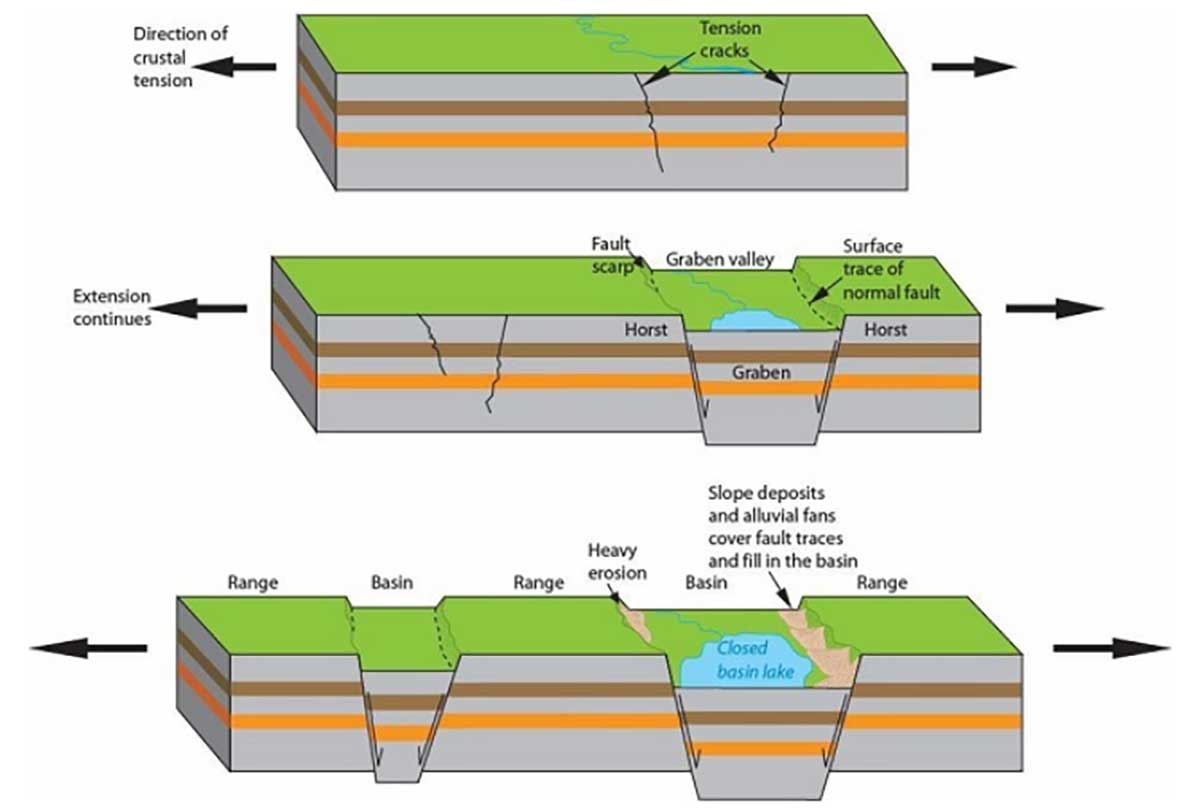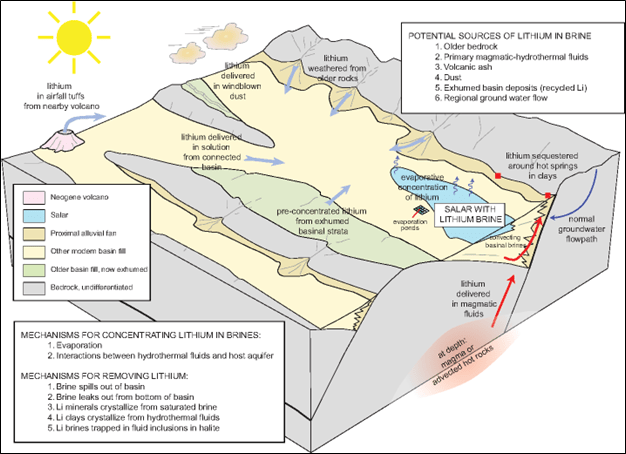PROJECTS OVERVIEW
Introduction to Ameriwest Projects
There are three types of lithium deposits. They are hardrock (e.g. pegmatites and spodumene), clays (e.g. hydrothermally altered clays or clays deposited in a lacustrine environment), and brines (e.g. continental, geothermal, and oil field brines).
Ameriwest currently has five high quality early stage lithium clay and continental brine exploration projects located in Nevada and Arizona, all with potential for delineation of lithium resources, subject to exploration success. They include:
- Thompson Valley Property, AZ
– lithium clay target - Edwards Creek Valley Property, NV
– lithium clay and brine target - Railroad Valley Property, NV
– lithium brine target - Deer Musk East Property, Clayton Valley, NV
– lithium brine target - Little Smoky Valley Property, NV
– lithium clay target
Sources of Lithium in Nevada and Arizona
Lithium brine and clay deposits in Nevada and Arizona are typically found associated with Tertiary age (2.6 to 66 million years ago) volcanic calderas. The last major episode of volcanism in the Tertiary age occurred from about 7 to 16 million years ago. These volcanoes produced felsic and rhyolitic tuffs (volcanic ash) containing lithium. Some of these tuffs subsequently became igneous or sedimentary rocks through lithification, diagenesis, and/or hydrothermal alteration (metamorphism). Hydrothermal alteration is defined as any alteration of rocks or minerals by the reaction of a hydrothermal fluid with a pre-existing solid phase.
Nevada and Arizona are prospective for lithium deposits because of the many calderas and volcanic fields of this age that exist in these states. Nevada hosts 80 mapped calderas ranging in ages from 34 million to less than six million years old. There are also ten major volcanic fields, many smaller volcanic fields, plus deposits of Tertiary age volcanic sediments throughout the state. Arizona also hosts calderas and volcanic fields formed during this period.
Tertiary volcanism also overlapped a period of Basin and Range faulting. Basin and Range faulting, associated with significant continental plate movement, occurred in Nevada and parts of Arizona around about 7-12 million years ago. This created hundreds of narrow mountain ranges and valleys lying more or less parallel and oriented more or less north-south. During the rifting process, graben blocks dropped as much as 10,000 feet relative to the horst blocks (mountains, as shown in the figure above).
Wind blown volcanic tufts, associated with Tertiary volcanics filled the valleys in layers up until about 7 million years ago as volcanism was occurring. In addition, erosion of material during the Tertiary and Quaternary ages to present occurred as material from adjacent mountains eroded due to water, wind, and glacial movement and were deposited into the valleys. Rocks, sand and gravel, clay, and silt gradually buried the graben block valleys under sediment in bedded layers, reaching depths as much as 5,000 feet. Some of these deposits, over time, formed sandstones, mudstones, siltstones, claystones, and shales. Often these deposits were formed in lacustrine environments in lakes that flooded the valley.
Sources of lithium are believed to be:
- Volcanic source rocks – typically found with low levels of lithium
- Lithium rich hydrothermal fluids interacting with volcanic source rocks or basin fill material
Natural groundwater flow is believed to mobilise lithium and transport it. Hence, lithium can be concentrated by groundwater flow or precipitation infiltration in volcanic source rocks. It can also be concentrated by groundwater flow into valleys from volcanic source rocks, through precipitation infiltration from surface runoff into valleys through eroded materials with lithium, or through evaporation of shallow basin fill waters in valleys that contain lithium. Geothermal sources such as hot springs can also be sources of lithium or a means to remobilize, move, and concentrate lithium.
Characteristics of Lithium Clay Deposits
The geological model and understanding of lithium claystone deposits is still evolving, and Ameriwest has improved its own understanding through boots-on-the-ground exploration. This field work has resulted in the discovery of two clay properties, Thompson Valley and Little Smokey Valley.
It is believed that “in place” volcanic sediments in the vicinity of volcanoes, in some cases, were hydrothermally altered and are characterised by higher grade concentrations of lithium. This could have been the result of geothermal water from volcanoes or associated vents, or from geothermal activity below the deposits. Lithium might have been mobilised by this hydrothermal activity and concentrated in various lithological units in the deposits. These types of deposits would typically be found in the mountains, adjacent to a valley.
With regard to eroded or windblown material that infilled the valleys, several depositional models may be in play. Sources of lithium might have been from hot springs in the drainage basin with lithium concentrations building up over geologic time. There might have been geothermal activity from an intrusion below the basin providing lithium rich fluids over geologic time. There might have been numerous evaporation periods of lithium rich lakes in a lacustrine environment, that, over time, concentrated lithium in various aquifers in a valley. Or water from sources on the adjacent mountains could have flown on surface or as groundwater into the valley concentrating lithium in various aquifers. A combination or all of the above could have occurred. In the case of the valley, both lithium clay or brine deposits could potentially be found, if the lithium is present and becomes concentrated in either the lithologic units and/or the aquifers.
Characteristics of Lithium Brine Deposits
With regard to brine deposits, Ameriwest’s exploration is focussed on continental brine deposits. Continental brine deposits are found in underground reservoirs, typically in locations with arid climate. The brines are contained in a closed basin, with surrounding rock formation being the source of the dissolved constituents in the brine. As outlined above, continental lithium brine properties are found in certain valleys in Nevada.
According to the United States Geological Survey (“USGS”) Open-File Report 2013-1006, Nevada hosts the best known continental lithium brine deposit in the world in Clayton Valley. Typically, in Nevada, playas or salars are found in basin valleys, representing an area of flat, dried up land (salt flat), from which water evaporated quickly. The six main characteristics of a closed basin where continental lithium brines are found are present in all of Ameriwest’s lithium brine properties. They include:
- Arid climate;
- Closed basin containing a playa or salar;
- Tectonically driven subsidence (basins formed by horst-graben faulting);
- Associated igneous or geothermal activity;
- Suitable lithium source-rocks;
- One or more adequate aquifers; and
- Sufficient time to concentrate Li-rich brines.
The figure above shows a closed basin that has been filled with sediments. Sources of lithium could be hot springs, magmatic fluids from below the valley, lithium weathered or eroded from adjacent mountains, and other possible sources. Typically a playa or salar is present and evaporation and precipitation of lithium in a brine solution over geologic time may build up lithium in aquifers at depth.
historic production meets prospective opportunities
Thompson Valley, Arizona
Thompson Valley (TV) is a 6,900-acre prospective lithium sedimentary deposit with surface or near-surface exposure of lithium-bearing clays located in central Arizona. Historic and recent sampling indicate lithium grades similar to those found in clay deposits in Clayton Valley, Nevada. Ameriwest’s surface sampling programs to date has found lithium in clays with concentrations of up to 1,295 ppm Li. The company is moving forward with permitting to drill this property.
Edwards Creek Valley, Nevada
Edwards Creek Valley (ECV) is in a hydro-geologically closed basin in north central Nevada. The drainage basin is similar in size and geologic potential as Clayton Valley. Ameriwest controls the entire playa area with its 22,300-acre property, strategically located two hours east of the Tesla’s Gigafactory. The property is optioned to Nova Lithium Corp. (CSE: NVLI) and hosts both lithium clay and lithium brine exploration targets, identified with geophysics.
Railroad Valley, Nevada
Railroad Valley (RRV) is in a hydro-geologically closed basin in central Nevada. It is within a large drainage basin four times the size of Clayton Valley. Ameriwest controls a 15,300-acre brine exploration property which has similar geologic characteristics to Clayton Valley. The property hosts a lithium brine exploration target identified with geophysics.
Deer Musk East, Nevada
Deer Musk East (DME) is a 7,400-acre property located on the eastern side of Clayton Valley, in what appears to be a down dropped block of ground known as a graben. Ameriwest believes this graven is a parallel structure to one where Albemarle’s (NYSE:ALB) Silver Peak Mine and Pure Energy Mineral’s (TSXV:PE) Clayton Valley Property are found. The property hosts a lithium brine target identified with geophysics.
Little Smokey Valley, Nevada
Little Smoky Valley (LSV) is a 5,800-acre green-fields lithium claystone property that hosts a sub-horizontal sequence of lacustrine and tuffaceous mudstones, claystones, and siltstones. It represents a lithium clay exploration target identified with geologic sampling. It surrounds POWR Lithium (CSE: POWR) Eli Lithium Property.



